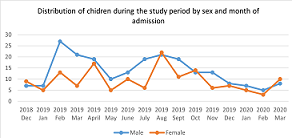Associated Comorbidities in Children under 5 Years with Severe Acute Malnutrition Attending Magumeri General Hospital: Retrospective Hospital-Based Study

Abstract:
Malnutrition is a global health
challenge essentially because of its role as a preventable cause of several
morbidities and mortality around the globe, especially in children under 5
years. Associated comorbidities and types of morbidity common in children
admitted with severe acute malnutrition in Magumeri General Hospital were
investigated. This was a retrospective quantitative hospital-based study.
Hospital records, ward admission and discharge registers, and patient cards
were reviewed focusing on demographic, clinical, and mortality data extracted
on all children under 5 years admitted to the Hospital. Data during the period
of December 2018 to March 2020 was collected and analyzed using Microsoft Excel
2013 and SPSS version 17.0. 367 children under 5 years with complicated SAM
were identified from the reviewed total hospital admissions of 537. 217 cases
were male (59.1%) while 150 were female (40.9%). Marasmus was the most common
type of severe acute malnutrition (75.2%) while diarrhea, respiratory tract
infection, and malaria were the top three comorbidities, majority of the cases
were managed successfully with 79.6 % reported to have fully recovered and were
discharged, while 17 (4.1%) died. Magumeri is a locality disproportional
affected by various insecurities due to the Boko Haram insurgency, resulting in
the high prevalence of severe acute malnutrition among children under 5 years,
representing 68.3% of total hospital admissions in the same age group, while
81.2 % had at least more than one comorbidity with a significant association
between prolonged hospital stay and treatment (p < 0.001).
References:
[1] World
Health Organization. Report on malnutrition worldwide. WHO, Geneva: 2000.
[2] Kelsey
D. J. Jones, James A. Berkley et al., 2014, Severe acute malnutrition and
infection. Pediatrics and International Child Health. DOI 10.1179/2046904714Z.
[3] WHO,
UNICEF, WFP, UN System Standing Committee on Nutrition., 2007, Joint Statement
on the Community-Based Management of Severe Acute Malnutrition. http://www.who.int/maternal_child_adolescent/documents/a91065/en/.
[4] WHO and
UNICEF., 2016, Ending Preventable Child Deaths from Pneumonia and Diarrhoea by
2025: The integrated Global Action Plan for Pneumonia and Diarrhoea (GAPPD),
WHO, Geneva, 2013 update.
[5] Baldwin
C., Parson TJ., 2004, Dietary advice and nutrition supplements in the
management of illness-related malnutrition: a systematic review. Journal of
Clinical Nutrition. 23:1267–1279.
[6] Chandra
RK., 1997, Nutrition and the immune system: an introduction. American Journal
Clinical Nutrition.; 66:460S–463S.
[7] Machanick
JI., 2004, Practical aspects of nutrition support for wound healing patients.
American Journal of Surgery.;188:52–56.
[8] Jones,
G., Steketee, R. W., Black, R. E., Bhutta, Z. A. & Morris, S. S., 2003,
Child survival II: How many child deaths can we prevent this year? The Lancet,
362, 65–71.
[9] National
Population Commission [Nigeria] and ICF Macro. 2013. Nigeria Demographic and
Health Survey (NDHS) 2013. Abuja, Nigeria: National Population Commission and
ICF Macro, Micronutrient Initiative. (2013). Nigeria Country Profile.
[10] WHO and
UNICEF., 2015, United Nations Inter-Agency Group for Child Mortality Estimation
(IGME), Levels and Trends in Child Mortality: Report 2015, UNICEF, New York,
2015.
[11] National
Nutrition and Health Survey (NNHS)., 2018, Report on The Nutrition and Health
Situation of Nigeria. Data source: National Bureau of Statistics,
https://nigerianstat.gov.ng/elibrary/read/839
[12] WHO
Report., 2013, Guideline: updates on the management of severe acute
malnutrition in infants and children. 2013
(http://apps.who.int/iris/bitstream/10665/95584/1/9789241506328_eng.pdf)
[13] National
Population Commission (NPopC)., 2017, National Strategy for The Development of
Statistics (NSDS) In Nigeria, 2017-2021. https://nigerianstat.gov.ng/
[14] Caulfield
LE, de Onis M, Blossner M., 2004, Undernutrition as an underlying cause of
child deaths associated with diarrhea, pneumonia, malaria, and measles.
American Journal of Clinical Nutrition. 2004 Jul. 80(1):193-8.
[15] Adama,
Z. W., Bengaly, M. D., AngÃ, Z., Virginio, P. & Ludovic, K. K., 2016,
Determinants of mortality in children under five years of age with severe acute
malnutrition admitted to the Valgado Ouã Draogo Teaching Hospital (Burkina
Faso). International Journal of Child Health and Nutrition, 5(1), 1-9.
[16] Derseh
Behailu, Kalayu Mruts, Takele Demie, and Tesfay Gebremariam., 2018,
Comorbidity, treatment outcomes and factors affecting the recovery rate of
under-five children with severe acute malnutrition admitted in selected
hospitals from Ethiopia: retrospective follow up study. 2018. Nutrition Journal
17:116
[17] Semsibie
Girum., Desta Mebrahtu., Teklemariam Gultie., 2015, Retrospective Assessment of
Malnutrition among under-five children in Ayder Referral Hospital, Tigray
Ethiopia. International journal of public health science. V2, No2.
[18] Williams
TN, Maitland K, Phelps L, Bennett S, Peto TE, Viji J, Timothy R, Clegg JB,
Weatherall DJ, Bowden DK., 1997 Plasmodium vivax: a cause of malnutrition in
young children. QJM. ;90(12):751–7.
[19] Munthali
Tendai., Choolwe Jacobs., Lungowe Sitali., Rosalia Dambe and Charles Michelo.,
2015, Mortality and morbidity patterns in under-five children with severe acute
malnutrition (SAM) in Zambia: a five-year retrospective review of
hospital-based records (2009–2013). Archives of Public Health 73:23
[20] Williams
Walana., Samuel Ekuban., Samuel Makinin., Ezekiel Kofi Vicar., 2016, A
Retrospective Study on Child Malnutrition in the Tamale Teaching Hospital,
Ghana. Journal of Scientific Research and Reports, DOI: 10.9734/JSRR/2016/23095
[21] Saka A,
Saka M, Adeboye M, Mokuolu O, Abu-saeed M, Abu-Saeed K., 2012, Malaria
parasitemia in children with PEM in North Central Nigeria. J Pharm Biol
Sci.;1(3):49–53.
[22] Oluwaremilekun
G. Ajakaye, Mojirayo R. Ibukunoluwa., 2019, Prevalence and risk of malaria, anemia,
and malnutrition among children in IDPs camp in Edo State, Nigeria.
https://doi.org/10.1016/j.parepi.2019.e00127
[23] Berkley
JA, Ngari M, Thitiri J, et al., 2016, Daily co-trimoxazole prophylaxis to
prevent mortality in children with complicated severe acute malnutrition:
a multicentre, double-blind, randomised placebo-controlled trial. Lancet Glob
Health.;4(7): e464-473.
[24] Black
RE, Victora CG, Walker SP, et al., 2013, Maternal and child undernutrition and
overweight in low-income and middle-income countries.
Lancet.;382(9890):427-451.
[25] Henry
Doctor V, Bairagi R, Findley SE, Helleringer S, Dahir T., 2011, Northern
Nigeria maternal, newborn and child health programme: selectef analyses from population-based
baseline survey. The open demography journal 2011:4:11-21.
[26] Endurance,
A. Ophori, Musa Y. Tula, Azuka V. Azih, Rachel Okojie and Precious E. Ikpo.
Current Trends of Immunization in Nigeria: Prospects and Challenges. 2014 June.
Tropical Med Health. 42(2): 67-75 doi 10.2149/tmh.2013-13.

